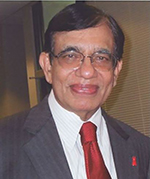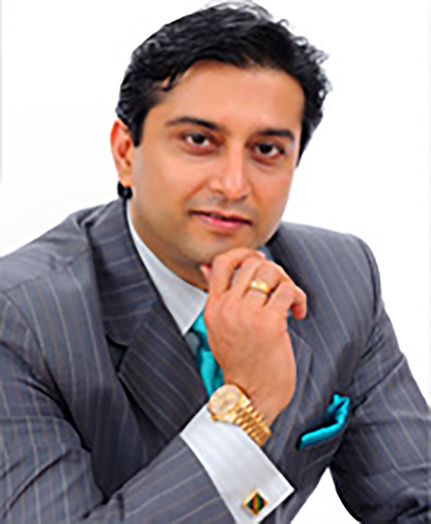
Cholesterol – What’s New? Part 3
Management of Heart Disease in South Asians

South Asians represent about 25 percent of the world’s population but they account for 60 percent of the heart disease that we see around us! This high incidence of coronary artery disease (CAD) in one ethnic group presents a major public health crisis. The Indian diaspora have: 1. Higher rates of CAD compared to compatriots of other ethnic origins, notably Chinese, blacks and whites 2. Premature onset of heart disease: Indians develop heart attack and die about 10 years earlier than in other populations. Heart attack rates are 3-to-5 fold higher in young Indians (<45 years of age in males and <55 years in females) than in other populations. 3. Severe degree of coronary atherosclerosis involving multiple coronary arteries – what Dr. Enas calls “malignant coronary disease”!
So, our efforts should be directed to how best we can prevent this menace. Fortunately, it has become a little easier with the new treatments of risk factors, especially hyperlipidemia, now available. There are new developments in cholesterol control, which we can use.
First and foremost is to tackle the risk factors. The standard risk factors for CAD applicable to other population exist in South Asians as well, like hypertension, obesity, smoking and high-fat diets. Since we, the transplanted Indians from our native India, also eat our share of saturated fat-laden rich foods, we have higher levels of cholesterol than our compatriots in India. As one author put it, “The integration of the typical South Asian diet with the Western diet has been cataclysmic.” Needless to say, these risk factors should be appropriately managed.
The three most important factors as documented in the MASALA study are: 1. Higher prevalence of diabetes and insulin resistance (T2D) compared to our Caucasian counterparts. Many young people are prone to development of T2D or already have the disease and not even aware of it. This calls for early intervention in the high-risk population that includes low-fat diet, increase in daily exercise (many of us are averse to moving around much) and reducing the body weight even further. Most South Asians are not obese by the Western criteria – their BMI is usually below 25 – but the World Health Organization recommends it should be even lower, like below 23 for South Asians. Another important factor is South Asians have higher incidence of abdominal obesity – elevated levels of visceral and hepatic fat, which are more atherogenic. Hence, steps should be taken to reduce through proper diet and exercise. Keep in mind, atherosclerosis may long precede the development of obstructive coronary disease and hence measures for prevention should start even from childhood.
The most important part of management is decreasing your total serum cholesterol and the bad cholesterol, LDL, to as low as possible. Modern studies have shown no adverse effect from low serum LDL. The main element in all atheromatous plaques is LDL without which there won’t be any obstructive coronary artery disease. We have now excellent drugs to bring down the LDL to low levels, like statins – atorvastatin and rosuvastatin, and another class, Ezetimibe. A new arrival Bempedoic acid is also quite effective. These drugs can be combined for maximum effect. A recent arrival is a biweekly injectable drug, a monoclonal antibody Evolocumab, designed to produce drastic reduction of LDL, quite useful for those who cannot tolerate high doses of statins. The latest in this category is ‘Incliseran’, the effect of which lasts for six months, hence need only twice a year injection. These are frequently used for high-risk patients, especially those who have had previous heart attacks. For some time, cardiologists have been talking about a prophylactic ‘vaccine’ that would be effective in the prevention of CAD and this new drug may well be the one that comes close to fulfilling the need. Also, more treatments are on the way, the most promising is ‘gene editing’ (CRSPR) to prevent atherosclerosis altogether. A wonderful fresh concept, indeed.
In conclusion, it’s so important for us to be aware of the high incidence of premature and severe heart disease and deaths in South Asians. Denial and lack of understanding of the disease can end in tragedy. With some modification of diet, regular exercise, prevention or control of Diabetes Mellitus and keeping the blood lipids low, CAD in South Asians can be controlled effectively.
M.P. Ravindra Nathan, M.D., is a cardiologist and Emeritus Editor of AAPI Journal. For further reading, “Second Chance - A Sister’s Act of Love” by Dr. Nathan from Outskirts Press, can be found at www.amazon.com
EYES WIDE OPEN IN THE NEW YEAR!

In 2023, make a resolution not to settle for “routine.”
Vision freedom without glasses and contact lens is no longer a far-reached dream. Demand custom-designed eye surgery, uniquely planned for your eye and its maximum vision potential. Over 70 percent of patients who fly to our practice from around the world come with complications and side effects of eye surgery most commonly; Lasik surgery, Smile (small incision lenticule extraction), PRK (Photorefractive keratectomy), cataract surgery, keratoconus, crosslinking, radial keratotomy, dry eyes and irregular astigmatism. In most cases, the obvious practice pattern is patients being treated as a number, lined up in waiting rooms, and then going through a surgery mill and landing at a mediocre outcome; left with no options.
Do not fall for advertising or discounts or deals, and remember, as I always teach, “Blindness at any bargain is not a good deal.” In numerous columns in this publication (KhaasBaat), I have explained the concept of Lasik being just one among 20 laser vision techniques. Similarly, cataract surgery can be performed in multiple custom-designed approaches using numerous technologies best suited for your individual eye.
Do not accept cataract surgery menu cards that provide a diamond, gold or routine lens option, providing you a choice of only three lens implants, claiming to be the best. There are more than 30 lens implants available in the United States and over 80 worldwide. Make sure that you are getting technology that is best suited to you, and not limited to a practice’s abilities or potential.
Most cataract surgeons (eye surgeons trained to remove cataracts and dysfunctional lenses) are not refractive surgeons (eye surgeons trained to correct vision errors like nearsightedness, farsightedness, astigmatism and reading vision). It is vital for your cataract surgeon to be armed with this dual level of skill and experience, dedicatedly measure and personally study all vision criteria and pick abnormalities special to each individual eye using cutting-edge diagnostic technologies. At the same time, measure the associated anatomy, physiology, optics and vision potential to then diligently surgical technologies and techniques (KLEAR™; full spectrum Kerato-Lenticulo-Refractive range of surgeries) in a holistic approach, individually tailored to each eye no matter how simple or complex it is.
This very concept is the founding principle of next generation cataract surgery; LenzOplastique®
It is also important to realize that “not a candidate” doesn’t mean you have no options. Your eye surgeon needs to be experienced and able to modify surgery and apply technology for your unique situation. For example, having high astigmatism or thin cornea or dry eyes does not mean you cannot see without glasses or contact lenses. There are next-generation Lasik techniques like LaZrPlastique® without blades, flaps or cuts that can safely be performed on such patients with excellent vision outcomes.
If unfortunately, you have had routine, cataract or Lasik surgery, or any eye surgery for that matter, do not lose hope. You can still be corrected to the best vision potential.
Become an advocate for yourself and the family by education and due diligence and research before a decision on eye surgery. Perhaps, it is the most important decision that’ll impact you for the rest of the life.
Insist on meeting with the surgeon, ask all questions you have, take time and come back for another consult to inquire, including what you may have learned from friends, family or Google. Get all answers clarified by requesting for proof of the doctor’s experience, track record of success and reputation.
Though there should be no 100 percent guarantees in medicine and destiny does play a role, it is your responsibility to take charge.
Every doctor tries their best to help patients, but it is a two-way communication and, especially before surgery, that it is important to accomplish not only the trust factor, but also ensure that the best ability and technology is being used, customized to your individual eyes. And, of course, in most cases this leads to an excellent vision and point.
So, make a resolution in this new year to not settle for cookie-cutter surgery or be treated as a number and refuse to be lined up in a surgery mill. Take a breath, take your time, do research, and go in with your “Eyes Wide Open.”
Wish you all a very Happy New Year!